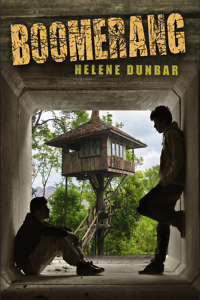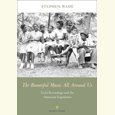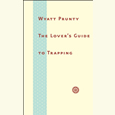Sometimes You Can Go Home Again
Helene Dunbar discusses her latest YA novel, Boomerang
In Helene Dunbar’s new young-adult novel, Boomerang, Michael Sterling returns home five years after his disappearance. A lot has changed since he was twelve: he has a new name, and his blond hair has been dyed black for years. What’s harder for Michael—now called Sean—to wrap his mind around are the changes in his mother and the friends he left behind, as well as the difficulties of navigating high school after living like a recluse with aging hippies Wilson and Maggie.
 Sean has a plan: to use a trust fund left him by his grandparents to rescue his troubled friend, Trip, but getting his hands on the money turns out to be complicated. And meanwhile Sean must decide which relationships to heal, how much of his other life to reveal, and whether he wants to face some uncomfortable aspects of his time away.
Sean has a plan: to use a trust fund left him by his grandparents to rescue his troubled friend, Trip, but getting his hands on the money turns out to be complicated. And meanwhile Sean must decide which relationships to heal, how much of his other life to reveal, and whether he wants to face some uncomfortable aspects of his time away.
Like Dunbar’s earlier YA novels, Boomerang takes an honest look at some difficult topics: friendship, responsibility, sexual and social identity, and the possibility of redemption. Dunbar, who lives in Nashville, answered questions from Chapter 16 via email.
Chapter 16: Did a particular situation spark the idea for Boomerang?
Helene Dunbar: In 2011 or so, I read Sara Zarr’s Sweethearts, the story of a girl whose childhood best friend/crush—who she was told had died—shows up without warning one day in high school. I thought the dynamics of that were fascinating, but I found that what I really wanted was the story from the boy’s point of view, since he was the one who had left. So following that adage, “write the book that you want to read,” I set out to do that.
When I was growing up, it seemed like there were a number of stories of children who were kidnapped and then were found and returned many years later. I was always fascinated by the psychology of that. How would they adapt? How would the families and friends who had been searching for them? In most cases, those situations were very tragic, but I started to wonder what would happen if the child in question actually left by choice and found a family that they believed suited them better.
Chapter 16: I remember those stories, too, and they always seemed to end when the child returned home. You made the interesting choice to start your story at the return instead. How did you manage the delicate balance of revealing enough to keep the reader satisfied while still holding back enough to keep them going? Did that take a lot of tweaking?
Dunbar: In all honesty, I tend to write out of order but tell my stories linearly. I actually had two different agents while I was revising this [novel], though, and they both pushed the book in a less obvious direction. I just kind of went along for the ride.
One thing I consciously did was to resist a lot of early-reader requests for more Trip scenes. I adore Trip in all of his subtly manipulative glory, but since Trip is elusive to everyone—including Sean, who knows him better than anyone—I wanted to make sure that the reader too was unable to pin him down. I think curiosity about his character is one element that keeps driving the story forward.
 Chapter 16: In the book’s acknowledgments, you mention tearing apart and sewing the manuscript back together. Can you explain what you mean by that?
Chapter 16: In the book’s acknowledgments, you mention tearing apart and sewing the manuscript back together. Can you explain what you mean by that?
Dunbar: I initially wrote this in dual points of view: those of Sean, the boy who returns, and Jenny, the girl who has been waiting for him. But it became clear that Jenny’s chapters weren’t as strong as Sean’s. Not only were my writing partners and readers not as invested in reading her chapters, but I wasn’t as invested in writing them. So I reconceived the book in Sean’s point of view alone, which meant cutting 30,000 words and changing the tense. It was a tough year.
Chapter 16: You call this “the book of my heart.” How so?
Dunbar: Well, first that rewrite into a single point of view really pushed the envelope for me, and I considered giving up far more than once. Then there were the various changes of agents and other publishing things that came up. So it was a book I fought long and hard for.
But more than anything, what I’m proudest of is that I kept the characters and their relationships complex and messy. I wanted a book where nothing was easily defined, and that includes Sean’s sexuality. Readers will (rightly) label him as bisexual, but he has spent his entire adolescence in a situation where no one would have thought to label him, and he wouldn’t have labeled himself. It’s actually very close to the end of the book before he even begins to have the vocabulary to question his attractions to, and love for, both Trip and Emery.
Sean and Trip—the boy that Sean comes back to “save”—are both perfectly suited for each other and massively dysfunctional. Sean and Emery—the girl he meets when he returns “home,” and who was present during a pivotal moment in Sean’s other life—have a totally different type of bond, one that is no less intense but which brings out completely different aspects of Sean’s character. Sean fights against a lot of his own feelings, and ultimately, as so often happens, his feelings win out.
In some ways, this is a book I never could have written when I was younger. When I was revising, U2 released “Ordinary Love” which is about how love pulls even strong people off their pedestals. There’s a question in the song, “Are we tough enough for ordinary love?” It isn’t “Can you handle being in a fairytale relationship where everything is flowers and candlelight?” but “Can you handle the day-in and the day-out and accept the people you love on their own terms even if you don’t like their decisions?”
This question is really the biggest difference between Trip and Sean. Trip is absolutely prepared to love Sean, flaws and all. Sean, however, expects the people in his life to be perfect, and it’s the hardest lesson of all to learn that none of them are.
Chapter 16: The boys’ personalities are very subtly but clearly drawn, but you keep physical descriptions of the characters to a minimum: we get nothing beyond hair and eye color for any of them. Why did you make this choice?
Dunbar: I’m not a very visual person, so when I read I kind of skip over all of that. Pinterest boards are a lot of work for me to put together because while I could tell you almost anything about my character’s emotions, in most cases, I don’t really get attached to their appearances.
Chapter 16: I get the feeling that despite Sean’s love for Wilson and Maggie, there’s something unsettling about them and their relationship with him. Comments?
Dunbar: I see Wilson and Maggie as two people who have a lot of love to give and wisdom to share, and no outlet for either of those qualities. An earlier draft explained that they had previously fostered a child who was returned to his birth mother, a move that ended badly, and, in a sense, they’re trying to make up for the loss of that earlier relationship. They truly love Sean and he truly loves them, although, again, he sees them as “perfect,” so it’s devastating to him to learn that these people he idolizes are fallible.
I set the novel in Maine, which is the only state that doesn’t make harboring a runaway a crime. Technically, then, Wilson and Maggie aren’t criminals, although I’m not advocating that people make the same choices they did.

Tracy Barrett is a writer who lives in Nashville. Her most recent book, Marabel and the Book of Fate, was published in 2018 by Little, Brown Books for Young Readers.




